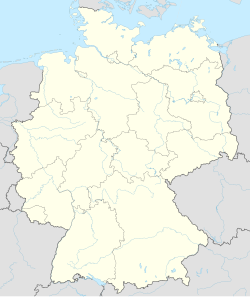Top Qs
Timeline
Chat
Perspective
Gellep-Stratum
Stadtteil of Krefeld in North Rhine-Westphalia, Germany From Wikipedia, the free encyclopedia
Remove ads
Gellep-Stratum is the southeasternmost district of Krefeld. The population is 2,485 (as of December 31, 2021). Until its incorporation into the city of Krefeld in 1929, Gellep-Stratum was a municipality in the Amt Lank of the Krefeld district.
This article needs additional citations for verification. (July 2025) |
Remove ads
Archaeology and history
Summarize
Perspective
Gelduba

In the southeast of present-day Krefeld, there are two ancient settlement cores. The one closer to the Rhine is Gelduba/Gellep. Here, the Romans built the fort Gelduba in the late 1st century AD near an Ubian village. Imperial troops used the fort until at least the middle of the 5th century AD.[2] After the Roman period, the Franks settled in the area. Albert Steeger discovered two cemeteries in 1937 ("Gellep-West" and the southern "Gellep-East") with Roman and Frankish graves. Gellep-West is the smaller and older of the two early medieval burial sites and is directly adjacent to the large Roman military cemetery.[3] The cemetery was in use until the early 8th century.[4] The nearby Gellep-East cemetery, though distinctly separate, dates back to around 535 AD, with a "prince's grave field" containing the grave of the Frankish prince Arpvar, who was buried with rich gold jewelry and a golden Spangenhelm. The settlement in Gellep likely continued in the fort, used by the Franks, as indicated by the discovery of a Frankish pottery kiln and a coin find.[5][6] After the Merovingians, this settlement in Gellep declined, although the current village part of Gellep has existed since the Middle Ages, with buildings and farms established on the former fort site and its vicinity.
Stratum
West of Gelduba lay another early medieval settlement, whose medieval successor is the present-day Stratum. Here, Albert Steeger discovered and excavated an early medieval cemetery, with about 200 known graves. Notably, the cemetery contains cremation graves and north–south oriented burials, which were unusual for the region.[7] In 1979/80, parts of the associated settlement were excavated in the field "Puppenburg".[8]

Finds from Gellep and Stratum are now on display at the Lower Rhine Landscape Museum in the Burg Linn Museum Center.
Middle Ages
In 904 and 910, Gellep appears in documents from the Kaiserswerth Abbey. Stratum is first mentioned in 1230 as Stratheim.[9]
From 1392 to 1794, Gellep and Stratum belonged to the Electoral Cologne Amt Linn.
Modern Era
In 1906, the Krefeld Rhine port was built and put into operation in Linn. The later expansion of the port now extends to Gellep, where today the turning basin of the port covers large parts of the former Roman village (vicus) and the Roman/Frankish cemetery.
Remove ads
References
Wikiwand - on
Seamless Wikipedia browsing. On steroids.
Remove ads




